2014 SUBARU TRIBECA headrest
[x] Cancel search: headrestPage 36 of 426

.Be sure to press the correctbutton to retrieve your registeredseat position. If the seat positionis not optimum for you, it mayadversely affect your driving andmay reduce the effectiveness ofthe seatbelt. That could result inan accident involving seriousinjury or death.
.When retrieving a registered seatposition, make sure the hands,feet and possessions of second-row seat passengers are clear ofthe seat adjusting mechanism.
.When any trouble or a malfunc-tion occurs during the retrieval ofthe seat position, stop the retrie-val of the seat position using anyof the control switches for man-ual adjustment, seat memory setbutton, seat memory registeredbutton 1 or 2.
1. With the select lever in the“P”posi-tion, press the desired button“1”or“2”.
2. The chime sounds once and the seatmoves to the registered position.
3. When the seat moves to the registeredposition, the chime sounds twice.
NOTE
.If a new position is registered for thesame button, the previous seat posi-tion is deleted..Even if the battery is disconnected,the registered seat position is notdeleted.
&Head restraint adjustment
1) Head restraint2) Release button
Both the driver’sseatandthefrontpassenger’s seat are equipped with headrestraints.
The head restraintshould be adjusted sothat the center of the head restraint isclosest to the top of the occupant’s ears.
Seat, seatbelt and SRS airbags1-5
–CONTINUED–
Page 40 of 426
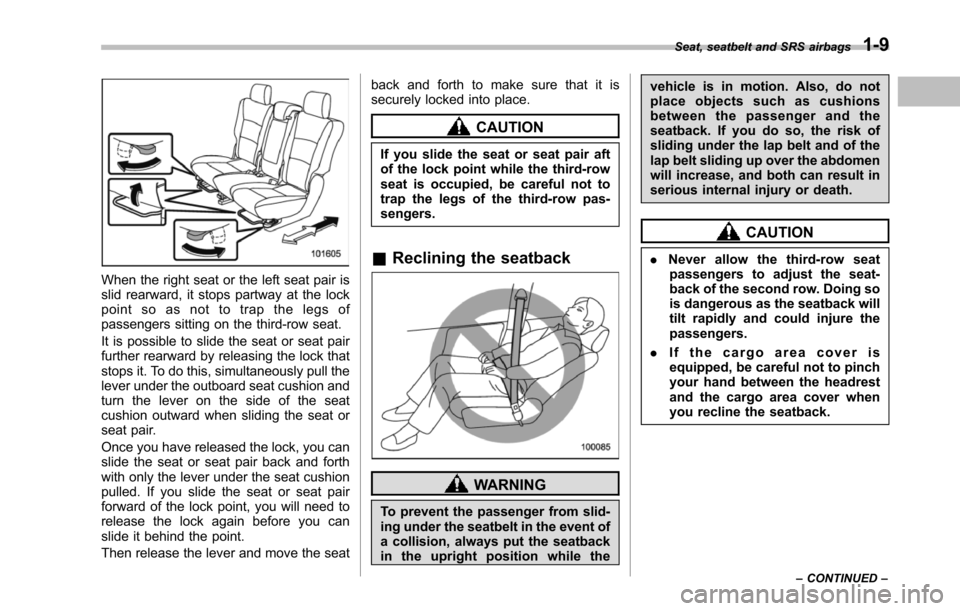
When the right seat or the left seat pair isslid rearward, it stops partway at the lockpoint so as not to trap the legs ofpassengers sitting on the third-row seat.
It is possible to slide the seat or seat pairfurther rearwardby releasing the lock thatstops it. To do this, simultaneously pull thelever under the outboard seat cushion andturn the lever on the side of the seatcushion outward when sliding the seat orseat pair.
Once you have released the lock, you canslide the seat or seat pair back and forthwith only the lever under the seat cushionpulled. If you slide the seat or seat pairforward of the lock point, you will need torelease the lock again before you canslide it behind the point.
Then release the lever and move the seat
back and forth to make sure that it issecurely locked into place.
CAUTION
If you slide the seat or seat pair aftof the lock point while the third-rowseat is occupied, be careful not totrap the legs of the third-row pas-sengers.
&Reclining the seatback
WARNING
To prevent the passenger from slid-ing under the seatbelt in the event ofa collision, always put the seatbackin the upright position while the
vehicle is in motion. Also, do notplace objects such as cushionsbetween the passenger and theseatback. If you do so, the risk ofsliding under the lap belt and of thelap belt sliding up over the abdomenwill increase, and both can result inserious internal injury or death.
CAUTION
.Never allow the third-row seatpassengers to adjust the seat-back of the second row. Doing sois dangerous as the seatback willtilt rapidly and could injure thepassengers.
.If the cargo area cover isequipped, be careful not to pinchyour hand between the headrestand the cargo area cover whenyou recline the seatback.
Seat, seatbelt and SRS airbags1-9
–CONTINUED–
Page 47 of 426
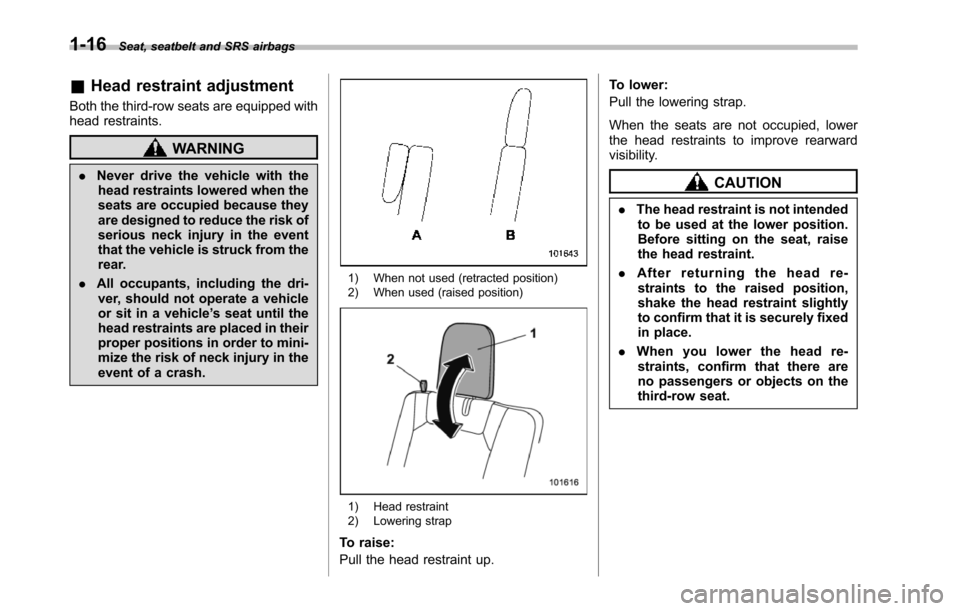
1-16Seat, seatbelt and SRS airbags
&Head restraint adjustment
Both the third-row seats are equipped withhead restraints.
WARNING
.Never drive the vehicle with thehead restraints lowered when theseats are occupied because theyare designed to reduce the risk ofserious neck injury in the eventthat the vehicle is struck from therear.
.All occupants, including the dri-ver, should not operate a vehicleor sit in a vehicle’s seat until thehead restraints are placed in theirproper positions in order to mini-mize the risk of neck injury in theevent of a crash.
1) When not used (retracted position)2) When used (raised position)
1) Head restraint2) Lowering strap
To raise:
Pull the headrestraint up.
To lower:
Pull the lowering strap.
When the seats are not occupied, lowerthe head restraints to improve rearwardvisibility.
CAUTION
.The head restraint is not intendedto be used at the lower position.Before sitting on the seat, raisethe head restraint.
.After returning the head re-straints to the raised position,shake the head restraint slightlyto confirm that it is securely fixedin place.
.When you lower the head re-straints, confirm that there areno passengers or objects on thethird-row seat.
Page 72 of 426
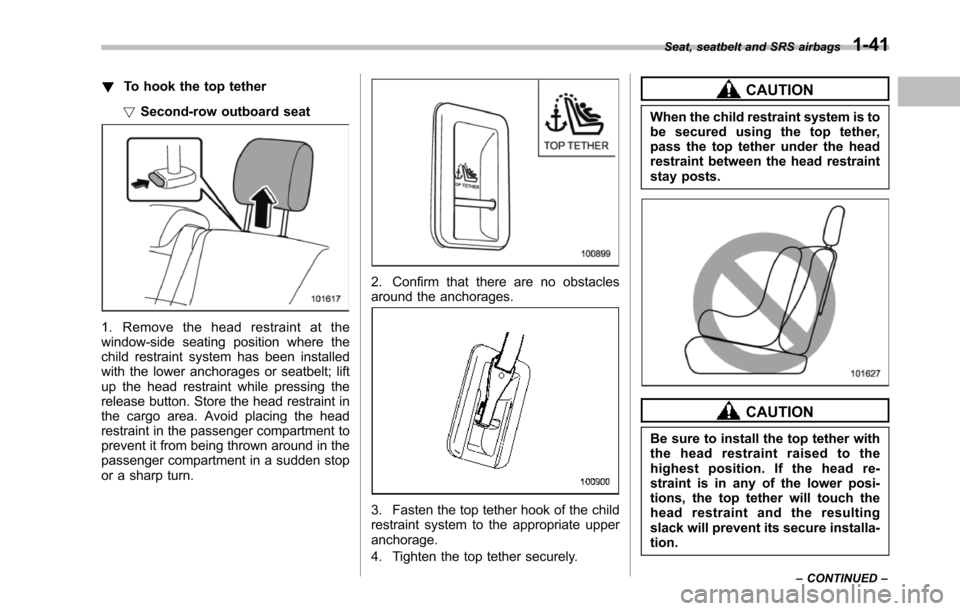
!To hook the top tether
!Second-row outboard seat
1. Remove the head restraint at thewindow-sideseating position where thechild restraint system has been installedwith the lower anchorages or seatbelt; liftup the head restraint while pressing therelease button. Store the head restraint inthe cargo area. Avoid placing the headrestraint in the passenger compartment toprevent it from being thrown around in thepassenger compartment in a sudden stopor a sharp turn.
2. Confirm that there are no obstaclesaround the anchorages.
3. Fasten the top tether hook of the childrestraint system to the appropriate upperanchorage.
4. Tighten the top tether securely.
CAUTION
When the child restraint system is tobe secured using the top tether,pass the top tether under the headrestraint between the head restraintstay posts.
CAUTION
Be sure to install the top tether withthe head restraint raised to thehighest position. If the head re-straint is in any of the lower posi-tions, the top tether will touch thehead restraint and the resultingslack will prevent its secure installa-tion.
Seat, seatbelt and SRS airbags1-41
–CONTINUED–
Page 74 of 426
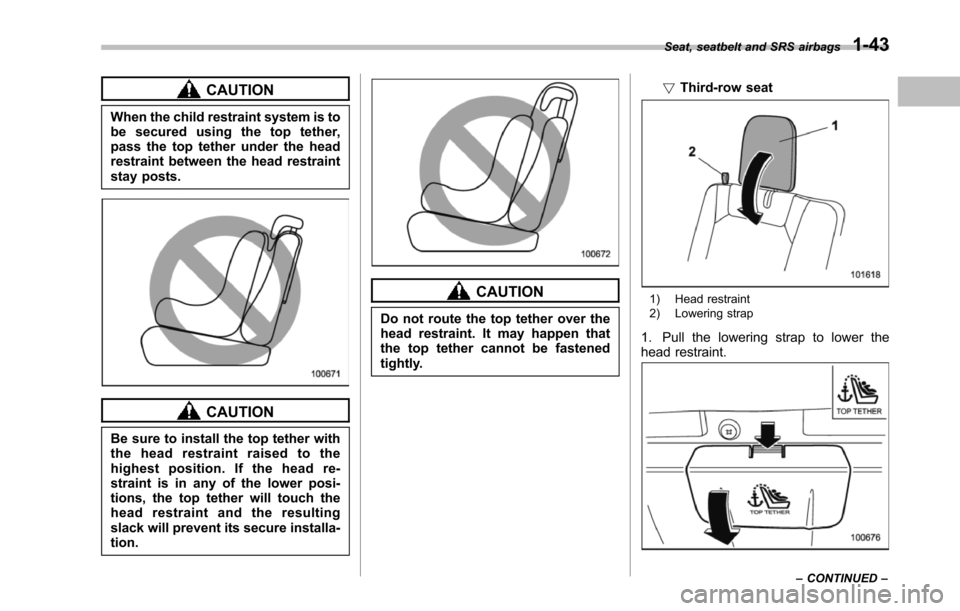
CAUTION
When the child restraint system is tobe secured using the top tether,pass the top tether under the headrestraint between the head restraintstay posts.
CAUTION
Be sure to install the top tether withthe head restraint raised to thehighest position. If the head re-straint is in any of the lower posi-tions, the top tether will touch thehead restraint and the resultingslack will prevent its secure installa-tion.
CAUTION
Do not route the top tether over thehead restraint. It may happen thatthe top tether cannot be fastenedtightly.
!Third-row seat
1) Head restraint2) Lowering strap
1. Pull the lowering strap to lower thehead restraint.
Seat, seatbelt and SRS airbags1-43
–CONTINUED–
Page 236 of 426
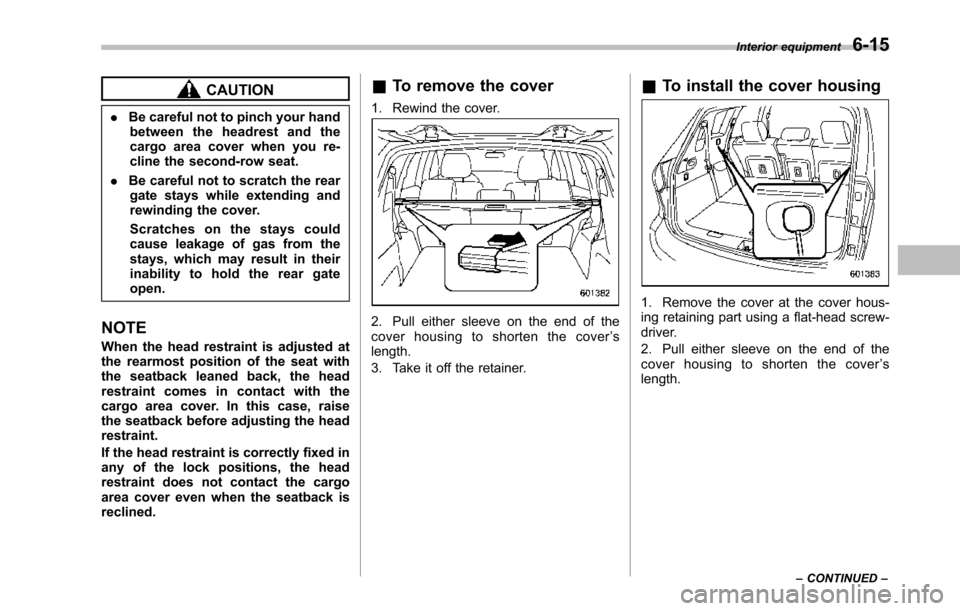
CAUTION
.Be careful not to pinch your handbetween the headrest and thecargo area cover when you re-cline the second-row seat.
.Be careful not to scratch the reargate stays while extending andrewinding the cover.
Scratches on the stays couldcauseleakage of gas from thestays, which may result in theirinability to hold the rear gateopen.
NOTE
When the head restraint is adjusted atthe rearmost position of the seat withthe seatback leaned back, the headrestraint comes in contact with thecargo area cover. In this case, raisethe seatback before adjusting the headrestraint.
If the head restraint is correctly fixed inany of the lock positions, the headrestraint does not contact the cargoareacover even when the seatback isreclined.
&To remove the cover
1. Rewind the cover.
2. Pull either sleeve on the end of thecover housing to shorten the cover’slength.
3. Take it off the retainer.
&To install the cover housing
1. Remove the cover at the cover hous-ing retaining part using a flat-head screw-driver.
2. Pull either sleeve on the end of thecover housing to shorten the cover’slength.
Interior equipment6-15
–CONTINUED–
Page 332 of 426
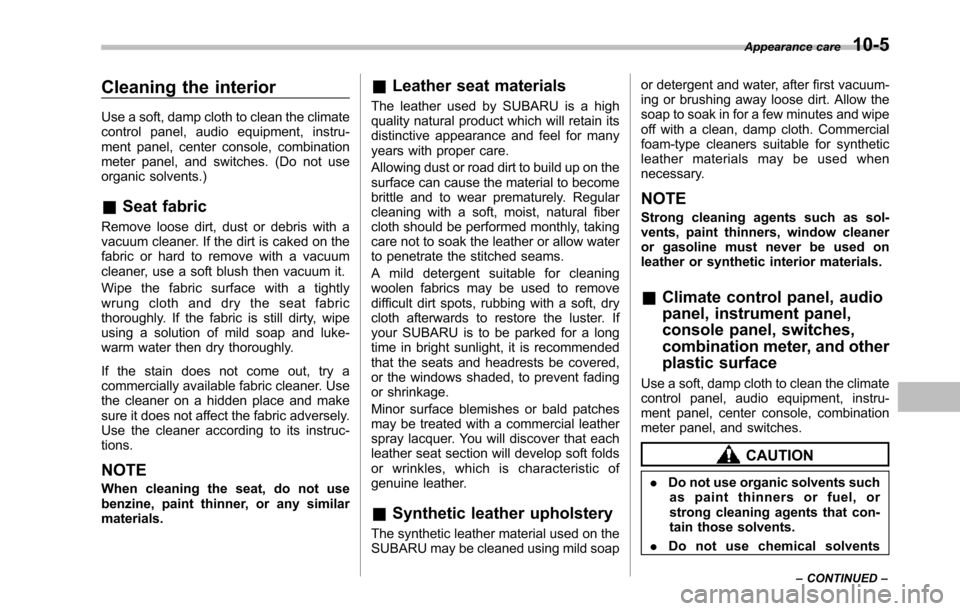
Cleaning the interior
Use a soft, damp cloth to clean the climatecontrol panel, audio equipment, instru-ment panel, center console, combinationmeter panel, and switches. (Do not useorganic solvents.)
&Seat fabric
Remove loose dirt, dust or debris with avacuum cleaner. If the dirt is caked on thefabric or hard to remove with a vacuumcleaner, use a soft blush then vacuum it.
Wipe the fabric surface with a tightlywrung cloth and dry the seat fabricthoroughly. If the fabric is still dirty, wipeusing a solution of mild soap and luke-warmwater then dry thoroughly.
If the stain does not come out, try acommercially available fabric cleaner. Usethe cleaner on a hidden place and makesure it does not affect the fabric adversely.Use the cleaner according to its instruc-tions.
NOTE
When cleaning the seat, do not usebenzine, paint thinner, or any similarmaterials.
&Leather seat materials
The leather used by SUBARU is a highquality natural product which will retain itsdistinctive appearance and feel for manyyears with proper care.
Allowing dust or road dirt to build up on thesurface can cause the material to becomebrittle and to wear prematurely. Regularcleaning witha soft, moist, natural fibercloth should be performed monthly, takingcare not to soak the leather or allow waterto penetrate the stitched seams.
A mild detergent suitable for cleaningwoolen fabrics may be used to removedifficult dirt spots, rubbing with a soft, drycloth afterwards to restore the luster. Ifyour SUBARU is to be parked for a longtime in bright sunlight, it is recommendedthat the seats and headrests be covered,or the windows shaded, to prevent fadingor shrinkage.
Minor surface blemishes or bald patchesmay be treated with a commercial leatherspray lacquer. You will discover that eachleather seat section will develop soft foldsor wrinkles, which is characteristic ofgenuine leather.
&Synthetic leather upholstery
The synthetic leather material used on theSUBARU may be cleaned using mild soap
or detergent and water, after first vacuum-ing or brushing away loose dirt. Allow thesoap to soak in for a few minutes and wipeoff with a clean, damp cloth. Commercialfoam-type cleaners suitable for syntheticleather materials may be used whennecessary.
NOTE
Strong cleaning agents such as sol-vents, paint thinners, window cleaneror gasoline must never be used onleather or synthetic interior materials.
&Climate control panel, audio
panel, instrument panel,
console panel, switches,
combination meter, and other
plastic surface
Use a soft, damp cloth to clean the climatecontrol panel, audio equipment, instru-ment panel, center console, combinationmeter panel, and switches.
CAUTION
.Do not use organic solvents suchas paint thinners or fuel, orstrongcleaning agents that con-tain those solvents.
.Do not use chemical solvents
Appearance care10-5
–CONTINUED–